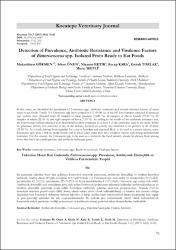Tüketime hazır bazı gıdalarda enterococcus spp. prevalansı, antibiyotik dirençlilik ve virülens faktörlerinin tespiti
Künye
Gokmen M. Onen A. Ektik N. Kara R. Torlak E. Metli M. Detection of Prevalence, Antibiotic Resistance and Virulence Factors of Enterococcus spp. Isolated From Ready to Eat Foods. Kocatepe Vet J. (2017) 10(2): 76-82.Özet
Bu çalışmada tüketime hazır bazı gıdalarda Enterokok türlerinin prevalansı, antibiyotik dirençliliği ve virülans faktörleri belirlendi. Analize alınan 187 gıda örneğinin 112 (%59,9)’sinde 114 Enterococcus spp. izole edildi. Et ürünlerinden 39 (%34,8), peynirlerden 42 (%37,5), salatalardan 25’i (%22,3) ve helva örneklerinden 8 (%7,1)’inde Enterococcus spp. izolatı elde edildi. Antibiyotik dirençlilik testi sonuçlarına göre, elde edilen Enterokok izolatlarının çalışmada kullanılan antibiyotiklerden en az dördüne dirençlilik gösterdiği tespit edildi. İzolatların hiçbirinde gelatinaz aktivitesi gözlenmezken, 36’sında (%31,6) hemolizin aktivitesi pozitif tespit edildi. Sonuç olarak starter kültür olarak kullanılabileceği ve insanlar için zararsız olduğu düşünülen bazı Enterokok türlerinin, virülens faktörler ve sahip olabilecekleri antimikrobiyal direnç bakımından halk sağlığı ve gıda güvenliği açısından bir risk oluşturabilmektedir. Bu nedenle gıda endüstrisinde starter olarak kullanılabilecek Enterokok türleri, patojenite özelliği bulunmayan ve antibiyotik direnç genlerine sahip olmayanlardan seçilmelidir. In this study, we identified the prevalence of Enterococcus spp., antibiotic resistance and several virulence factors of some ready-to-eat foods. Totally 114 Enterococcus spp. were isolated in 112 (59.90 %) of the 187 food samples analysed. Enterococcus spp. isolates were obtained from 39 samples of meat products (34.80 %), 42 samples of cheese brands (37.50 %), 25 samples of salads (22.30 %) and eight samples of halva (7.10 %). According to the results of the antibiotic resistance test, the Enterococci isolates obtained were determined to show resistance to at least 4 of the antibiotics used in the study. While no gelatinase activity was observed in any of the isolates, haemolysin activity was observed to be positive in 36 of them (31.60 %). As a result, having been regarded for years as harmless and reported likely to be used as a starter culture, some Enterococcus spp. pose a risk to public health and to food safety since they have virulence factors and strong antimicrobial resistance. For this reason, the Enterococcus spp. to be used as a starter in the food industry should be chosen from among those that don’t have pathogenicity and antibiotic resistance genes.



















